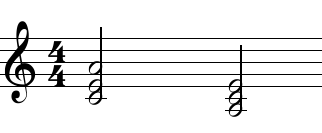Answer: This is a lot like question 102, but of course with different notes. This time I can already tell you that the shortcut method, the method that works when J. Evans is otherwise engaged, is to play the notes when in the "chord layer" of Songworks 3, and see what it says. Here's what it says:

But I'll explain the "manual" technique too:
The notes CEA can be more easily identified as a triad if you rearrange them as a stack of thirds. If three pitches can be adjusted by octave so that they form a neat stack, they are a triad. Move the A down an octave and it forms a third below the C:

When three pitches are arranged in "root position" this way it is easy to see that A is the root. And since the first third upward from A, A to C, is a minor third, and the next one is a major third, we have here a healthy specimen of the A minor triad.
Now that we know those three pitches form a triad, it doesn't matter what order they're in: they're still a triad, but they can be in various "inversions."
When arranged as CEA ascending, you could say the A minor triad is in "first inversion," because the original triad's middle note is now in the bass (lowest) position. If you moved that C up an octave, so that the E was in the bass, then the triad would be in "second inversion." And that pretty much is the limit of what you can do with those three pitches, harmony-wise.

But the difference between this question and #102 is that you mention the key. That kind of suggests you want to know what the chord's name would be with respect to the key of F. That's where Roman numerals come in. Now that we know the root of the chord is A, we ask: what scale degree is A in the key of F? The F major scale begins, F, G, A, so A is the third scale tone. Remembering that the convention with Roman numerals is to use lower-case for minor chords and upper case for major ones, the chord is "iii." Add the shorthand for first inversion, which is "6", and the chord is iii6 in the key of F. In a pop chart you wouldn't use the music-theory class notation, though - if you wanted to specify the inversion in a chart you'd just put the desired bass note after a slash, like this: Am/C.

